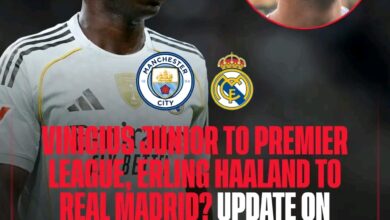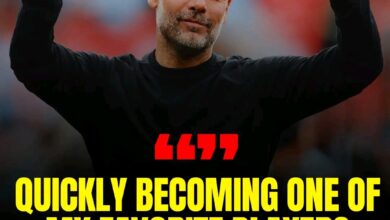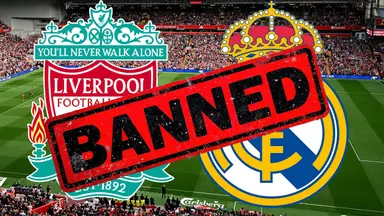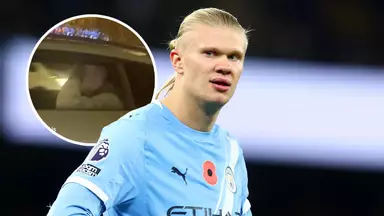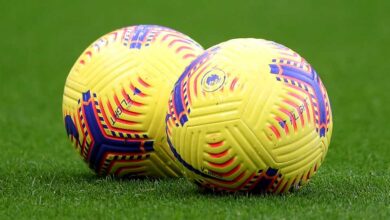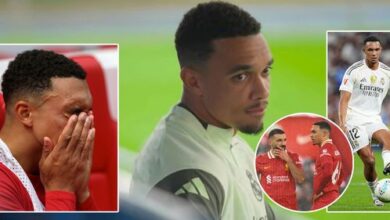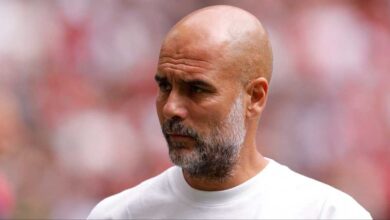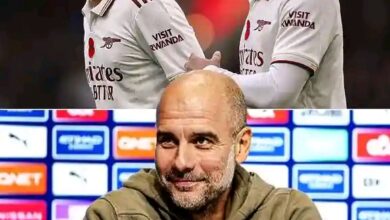Man City could smash transfer record on £115m PL star after scouts dazzled
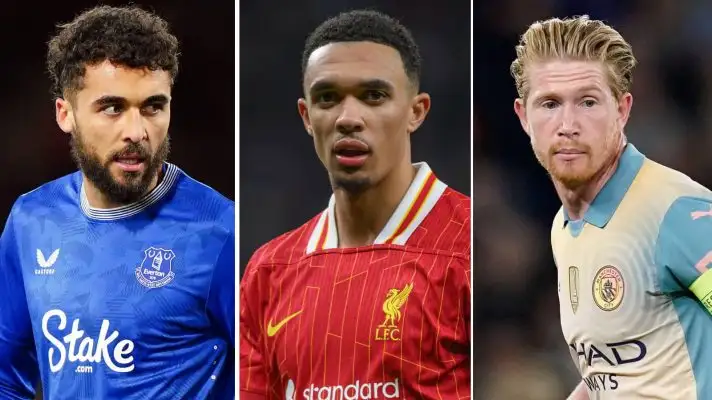
When Brighton & Hove Albion secured the signature of a relatively unknown Carlos Baleba from Lille in August 2023 for approximately £23 million, few outside the club’s meticulous scouting department could have predicted the meteoric rise that would follow. The Cameroonian midfielder, just 19 years old at the time of his arrival, was viewed as another astute acquisition by the Seagulls’ renowned talent identification system—a potential successor to Moises Caicedo, who had departed for Chelsea in the same transfer window.
Fast forward less than two years, and Baleba has not only filled the considerable void left by Caicedo but has arguably surpassed his predecessor’s impact at the Amex Stadium. The now 21-year-old midfielder has developed into one of the Premier League’s most dominant central midfielders, combining physical prowess with technical excellence and tactical intelligence beyond his years.
“His adaptation to Premier League football has been nothing short of remarkable,” notes former Brighton midfielder Gary Stevens. “You typically expect a bedding-in period for young players coming from abroad, especially in such a demanding position, but Baleba hit the ground running and hasn’t looked back.”
It’s this rapid development that has caught the attention of Manchester City’s extensive scouting network, with multiple sources confirming that the reigning Premier League champions have been monitoring Baleba throughout the current season with increasing interest.
City’s Midfield Conundrum
Manchester City’s interest in Baleba comes at a critical juncture for Pep Guardiola’s side. The Cityzens have navigated most of the 2024/25 campaign without the irreplaceable Rodri, whose ACL injury in September left a gaping hole in their midfield. The Ballon d’Or winner’s absence has been keenly felt, despite City’s admirable resilience in maintaining their challenge across multiple competitions.
Rodri’s importance to City’s system cannot be overstated. The Spanish international has been the metronome of Guardiola’s team, dictating tempo, providing defensive cover, and linking play between defense and attack with unparalleled efficiency. His anticipated return before the season’s conclusion will provide a significant boost, but his lengthy absence has underscored City’s vulnerability when deprived of his services.
The January acquisition of Nico Gonzalez represented a short-term solution, with the former Barcelona midfielder offering similar technical attributes, if not the same physical presence or tactical understanding that Rodri brings. While Gonzalez has shown promise, City’s hierarchy recognizes the need for longer-term planning, particularly with several key midfielders potentially approaching the end of their time at the Etihad Stadium.
Kevin De Bruyne, the club’s creative talisman for the past eight years, has been the subject of intense speculation regarding a lucrative move to Saudi Arabia. At 33, the Belgian maestro remains a world-class talent, but his injury record and reported interest in a new challenge suggest his glittering City career may be drawing to a close.
Similarly, Bernardo Silva—despite signing a contract extension last summer—continues to attract interest from Barcelona and Paris Saint-Germain. The Portuguese international has been a model of consistency for City, but at 30, the club may view this summer as the final opportunity to command a significant fee for his services.
Mateo Kovacic, signed from Chelsea in 2023, has been a dependable squad member but has never established himself as an automatic starter, while İlkay Gündoğan’s return from Barcelona has provided experience rather than long-term stability. With Kalvin Phillips expected to make his loan move to West Ham permanent and youngster James McAtee attracting interest from multiple Premier League clubs, the stage appears set for a significant midfield restructuring at the Etihad.
The Baleba Blueprint
According to Manchester City correspondent Jack Gaughan, Baleba has emerged as the priority target to spearhead this midfield regeneration. City’s scouting reports have been universally positive, highlighting the Cameroonian’s remarkable blend of attributes that align perfectly with Guardiola’s demanding requirements for a central midfielder.
Standing at 6’1″ with an impressive physical presence, Baleba offers the defensive solidity and ball-winning capabilities that City have occasionally lacked in Rodri’s absence. His tackling success rate of 74% ranks among the Premier League’s elite, while his ability to cover ground rapidly makes him an effective shield for the back four.
However, it’s his technical quality in possession that has particularly impressed City’s scouts. Baleba combines his defensive diligence with a passing range and ball progression statistics that rival the league’s most accomplished playmakers. His pass completion rate of 91.8% is complemented by an ability to break opposition lines with vertical passes and carries, advancing possession into dangerous areas with controlled aggression.
“What makes Baleba special is his completeness,” explains tactical analyst Michael Cox. “Most young midfielders excel either defensively or in possession, but he’s already elite in both aspects. He can anchor a midfield like Rodri, drive forward like Yaya Touré, or pick a pass like Fernandinho in his prime. That versatility is gold dust for coaches like Guardiola.”
Brighton insiders believe this all-around excellence makes Baleba an even more valuable asset than Caicedo, whose £115 million transfer to Chelsea currently stands as the Premier League’s record deal. While Caicedo’s defensive numbers were marginally superior at the time of his departure, Baleba offers significantly more in attacking phases, with more goal contributions, progressive passes, and successful dribbles per 90 minutes.
This offensive upside, combined with his defensive stability, explains Brighton’s astronomical valuation. Sources close to the club confirm they would expect any suitor to exceed the Caicedo fee, potentially setting a new British transfer record in the process.
The Financial Equation
Such a valuation presents a significant challenge, even for a club with Manchester City’s resources. The Abu Dhabi-owned club has traditionally been reluctant to engage in the kind of headline-grabbing deals that have become the hallmark of rivals like Chelsea, Manchester United, and more recently, Newcastle United.
City’s transfer record currently stands at the £100 million paid to Aston Villa for Jack Grealish in 2021, a deal that was heavily influenced by a release clause rather than protracted negotiations. The club’s hierarchy has generally preferred to spread their investment across multiple positions rather than allocating substantial resources to a single acquisition.
However, several factors could influence a departure from this strategy. First, the potential sales of De Bruyne, Silva, and others would generate significant funds to reinvest. Conservative estimates suggest City could raise £100-120 million from player sales this summer, effectively offsetting much of the Baleba outlay.
Second, City’s strategic planning has evolved in recent years, with an increasing focus on acquiring elite young talent who can contribute immediately while offering long-term value. The signings of Erling Haaland, Jérémy Doku, and Joško Gvardiol exemplify this approach—substantial initial investments that are viewed as decade-long assets rather than short-term solutions.
At 21, Baleba fits this profile perfectly. A five or six-year contract would secure his services through what are typically a midfielder’s prime years (22-27), with the potential for either a lucrative extension or significant resale value thereafter.
Finally, there’s the strategic importance of the holding midfield position in Guardiola’s system. The difficulties City have experienced without Rodri this season have reinforced the need for elite specialists in this role, with the manager himself describing it as “the most important position in modern football” during a recent press conference.
Financial fair play considerations remain relevant, but City’s commercial growth and potential player sales should provide sufficient headroom within UEFA’s regulations. The club’s financial team has demonstrated considerable expertise in navigating these constraints while maintaining competitive investment in the squad.
The Competition
Manchester City’s interest in Baleba is far from exclusive. The midfielder’s performances have attracted attention from across Europe’s elite clubs, with Chelsea and Liverpool most prominently linked in English media reports.
Chelsea’s interest carries a certain irony given their record-breaking acquisition of Caicedo from Brighton just two seasons ago. The Blues’ aggressive transfer policy under the Clearlake Capital ownership shows no signs of abating, with the club reportedly willing to sanction another nine-figure outlay despite questions about their own FFP compliance.
The West London club’s midfield has yet to find a settled configuration despite significant investment, with neither Caicedo nor Enzo Fernández fully justifying their enormous price tags to date. New manager Enzo Maresca is believed to have identified midfield balance as a priority area for improvement, with Baleba viewed as a potential cornerstone of Chelsea’s rebuilding project.
Liverpool’s involvement appears more peripheral at this stage. While the Reds admire Baleba’s talents, their transfer history under FSG ownership suggests reluctance to engage in bidding wars at the very top end of the market. The club’s recent pursuit of Martin Zubimendi indicates their interest in the position, but their failure to secure the Spanish international’s signature has seen them pivot toward alternative targets in a lower price bracket.
Arsenal and Manchester United have also been credited with tracking Baleba, though neither appears to have advanced their interest beyond preliminary scouting at this stage. On the continent, Paris Saint-Germain and Bayern Munich represent potential destinations, with both clubs seeking long-term replacements for aging midfield anchors.
This competitive landscape creates a challenging environment for negotiations. Brighton’s excellent financial position—bolstered by recent high-profile sales and shrewd reinvestment—means they face no pressure to sell below their valuation. The club’s owner, Tony Bloom, is renowned for his firm stance in transfer negotiations, as evidenced by the protracted sagas involving Caicedo, Marc Cucurella, and Alexis Mac Allister in recent years.
For Manchester City, securing a deal will require not only financial commitment but also convincing Baleba that the Etihad Stadium represents the ideal environment for his continued development. The prospect of working under Guardiola—widely regarded as the premier coach for midfield talents—provides a compelling attraction, as does the opportunity to compete for major honors immediately.
Tactical Integration
Should City succeed in bringing Baleba to Manchester, his integration into Guardiola’s sophisticated tactical framework would be fascinating to observe. The Catalan coach has consistently evolved his approach during seven years in English football, with the midfield configuration central to these adaptations.
The most intriguing possibility involves pairing Baleba with a returning Rodri in a double pivot—a setup Guardiola has occasionally employed against elite opposition. This arrangement would provide exceptional defensive security while allowing both players to showcase their ball progression abilities. It would also potentially enable more attacking freedom for City’s advanced midfielders and wingers, with two elite screeners covering defensive transitions.
Alternatively, Baleba could be deployed as Rodri’s primary rotation option, ensuring City maintain their midfield control regardless of personnel. The demanding schedule of modern football, with City regularly competing deep into four competitions, necessitates quality depth across all positions. Rodri’s recent injury highlights the risks of over-reliance on a single player, regardless of their excellence.
A third, more revolutionary approach would see Baleba replace Rodri as the first-choice holding midfielder, with the Spaniard potentially moving into a more advanced role or being deployed in specific tactical matchups. While this seems the least likely immediate outcome given Rodri’s status as the world’s premier defensive midfielder, it could represent a longer-term evolution of City’s midfield structure.
“Guardiola loves players who can fulfill multiple tactical functions,” notes Spanish football expert Guillem Balagué. “What makes Baleba so attractive is that he gives Pep new possibilities. He could play alongside Rodri, rotate with him, or even allow Rodri to move into areas where his passing range could be even more damaging. That tactical flexibility is priceless for a coach who is constantly seeking new solutions.”
Brighton’s Perspective
From Brighton’s standpoint, the potential departure of their midfield linchpin represents a familiar scenario. The club’s business model has been built around identifying talent early, developing players in a sophisticated tactical system, and selling at peak value to fund the next generation of recruitment.
This approach has served them remarkably well, with the club establishing itself as a consistent top-half Premier League outfit despite regularly losing key players to wealthier rivals. The sales of Ben White, Yves Bissouma, Leandro Trossard, Alexis Mac Allister, Moises Caicedo, and Marc Cucurella have generated in excess of £300 million in recent years, yet Brighton’s on-field performance has remained largely unaffected.
Much credit for this resilience goes to the club’s recruitment department, led by technical director David Weir following the departure of the highly-regarded Paul Winstanley to Chelsea in 2022. Brighton’s scouting network continues to identify emerging talent across global markets, with particular success in South America, France, and Eastern Europe.
Should Baleba depart this summer, the Seagulls already have potential replacements on their radar. Ecuador international Piero Hincapié has been extensively scouted, while Ghanaian midfielder Ibrahim Sulemana has impressed at Cagliari this season. The club’s academy has also begun producing first-team ready talent, with Jack Hinshelwood’s breakthrough this season demonstrating the strength of Brighton’s development pathway.
While losing a player of Baleba’s caliber would undoubtedly be felt, the £115+ million fee would provide substantial reinvestment capital, allowing Brighton to sign multiple high-potential replacements while strengthening other areas of their squad.
The Bigger Picture
Manchester City’s pursuit of Baleba represents more than just another high-profile transfer. It signals a recognition that, despite their domestic dominance, continuous evolution is necessary to maintain their position at the summit of English and European football.
The midfield has been the foundation of City’s success under Guardiola, with the technical excellence of players like David Silva, De Bruyne, Fernandinho, and Rodri enabling the positional play that has become the team’s hallmark. As key personnel change, maintaining the technical and tactical standards in this area becomes paramount.
Baleba’s potential arrival would also reflect shifting dynamics in the Premier league’s transfer landscape. Brighton’s ability to command such a substantial fee for a player with less than two full seasons of Premier League experience demonstrates both the inflation of the market and the growing recognition of the Seagulls’ development model.
For Carlos Baleba himself, a move to Manchester City would represent a remarkable ascent. Just three years ago, he was playing in the lower tiers of French football with Lille’s reserve team. Now, he stands on the verge of becoming one of the most expensive footballers in history and potentially a cornerstone of one of Europe’s elite clubs.
The coming months will determine whether this transfer materializes and at what price. What seems certain is that Baleba’s star will continue to rise, whether at the Amex Stadium or the Etihad. For Manchester City, the pursuit of excellence continues—and in Carlos Baleba, they may have identified the next piece in Guardiola’s evolving masterpiece.
What’s Next
As the season progresses toward its conclusion, Manchester City’s scouting team will continue to monitor Baleba’s performances while the club’s hierarchy assesses the financial viability of what would be a landmark deal. Brighton, meanwhile, will be preparing contingency plans while hoping that a bidding war develops among Europe’s elite.
For fans of both clubs, this summer promises to be another fascinating chapter in the Premier League’s ever-evolving transfer narrative. Whether Baleba becomes the latest Brighton star to secure a record-breaking move or remains to further enhance his reputation on the South Coast, his emergence as one of football’s most coveted young talents represents another triumph for a club that continues to punch above its traditional weight in the identification and development of elite players.
As one Brighton insider succinctly put it: “Carlos is special—the complete modern midfielder. Whoever gets him is signing a player who could dominate for the next decade. If City are serious, they’ll need to break the bank, but history suggests they rarely miss when they identify a priority target.”
The stage is set for what could become one of the summer’s most significant transfer sagas. Manchester City rarely fail to secure their primary targets, but in Brighton, they face opponents well-versed in extracting maximum value from reluctant buyers. For Carlos Baleba, the future looks bright, regardless of which shade of blue he’s wearing next season.






